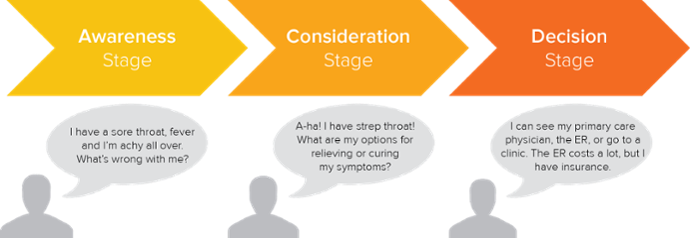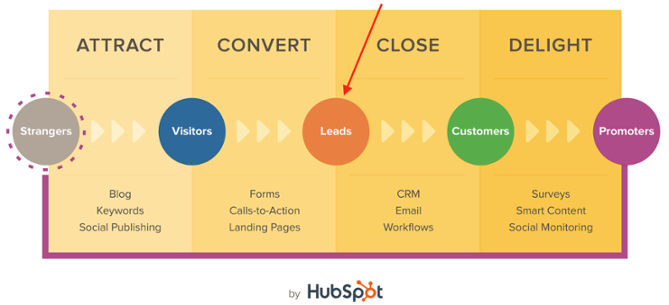02/27/19
Inbound Marketing and the Customer Journey: 2 Buzzwords Worth Paying Attention To
Marketing automation. Micro-moments. Native storytelling. There are plenty of buzzwords swirling around the digital universe right now. Two absolutely worth paying attention to are inbound marketing and the customer journey.
Chances are good that you’ve already heard these and may even use them. At OBI Creative, we incorporate inbound marketing and the customer journey into every project we tackle for our clients because we understand that proper execution of them is essential to marketing success.
Here, we break down the benefits of inbound marketing, share some of the best inbound marketing strategies and make the case for including inbound marketing and the customer journey in your business vocabulary.
Where are your ideal audiences why should you care about the customer journey?
Around the lunch table the other day, we overheard part of a conversation about the best sci-fi series on television. The semi-serious debate turned hilarious when one person said to the other, “It’s Star Trek! Not Star Track! They’re on a journey, not a treadmill!”
Whether you’re a sci-fi fan or not, that line is super helpful in understanding what approach you’re taking to marketing to your customers. If you realize that every interaction your customers have with your brand is part of a journey they are on that moves them from having no relationship with your business to arriving as a loyal advocate, then you believe in and practice the idea of customer journey.
If you believe instead that you can broadcast your message to your customers who will statically receive it and act accordingly, in practice, you’re thinking of them as being on a treadmill instead of a journey.
Customer journey is the new reality. The Internet saw to that when it dealt brand loyalty a death blow. Brands cannot expect customers to stay with them today because they delighted them yesterday. The consumer sentiment is largely, ‘what have you done for me lately’ and not ‘I love what you did for me two years ago.’
Inbound marketing is better than broadcasting and here’s why.
Even if your brand doesn’t run TV commercials, buy outdoor billboards or purchase air time on satellite radio, you might be guilty of designing your marketing strategy with a broadcast mindset instead of an inbound marketing mindset.
What’s the difference?
Let’s answer that question with a quick and painless quiz. Think about the most recent campaign you ran.
- How many of your messages were about your products or services?
- Did your display ads talk about product benefits or features?
- Do your last five blog posts talk more about your customers’ problems or your brand’s solutions?
If your marketing messages talk largely about your products and services, you may be approaching marketing from a broadcast mindset. Inbound marketing is different because it appreciates that customers interact with your brand at different points in the buying process.
It understands that customers are on a journey, not a treadmill.
Inbound marketing and customer journey go together like peanut butter and jelly.
We practice inbound marketing religiously, and not just because we’re a Hubspot-certified agency. It’s because our roots are in research and it, along with strategy, underpins everything we do for our clients. It’s why we developed the O’Brien Voice of the Customer (o.VOC), our study of the experience or interaction between a company and its customers from their perspective.
Inbound marketing presumes that the goal of marketing is to delight your customers. The better you understand your customers — what makes them tick and what ticks them off, the more leads (and sales) your marketing efforts will generate. Delight is not only how you define inbound marketing, it is central to how to do inbound marketing.
Just as important as understanding your customers’ pain points, is knowing what stage of the buying process they are in and then tailoring your marketing messages to that stage.
Defining the Three Stages of the Customer Journey

The Buyer’s Journey Example via Hubspot.
Inbound marketing leverages awareness of the customer journey in its four-step methodology:

The Hubspot Inbound Methodology via Hubspot.
Knowing where your contacts and clients are in the customer journey helps you send the right messages to the right people at the right time, which results in marketing success for you AND your customers! This is how inbound marketing and the customer journey fit together.
Attract the Right People
In the awareness consideration stage, you want to attract your audience with information that addresses their problems. Since people at this stage are just realizing they have a problem, keep your content focused around that and keep your solutions out of it.
Convert Leads into Customers
In the consideration stage of the customer journey, people have defined their problems and are actively researching ways to solve them. Forms, calls to action and landing pages can all be tools to help you provide your prospects with information about the benefits and features of products or services that can help meet their needs or solve their problems. Think of your brand as a helpful resource, providing the information they need to make an informed decision.
Close Sales with Timely Content
In the decision stage, your audience is finally ready for your sales pitch because they now know what their problem is, what solution they want and are ready to buy. If you’ve built trust and delighted them along the way, they will naturally turn to you, their trusted resource, for their purchase.
Delight Your Base
After the sale, continue to market to your new customers with information that delights them. The best inbound marketing strategies include surveys, smart content and social monitoring because all are helpful ways to nurture the relationship you enjoy and keep customers coming back to you for their ongoing needs.
What questions do you have about the benefits of inbound marketing? Do you use buyer personas as part of your inbound marketing strategies? How do you do inbound marketing at your agency or business?



